Xeriscape Landscaping Plants For The Arizona Desert Environment.
Pictures, Photos, Information, Descriptions,
Images, & Reviews.
Shrubs.
Mexican Bird Of Paradise, Caesalpinia mexicana.
We Are Proud Of Our SafeSurf Rating!
Click On Any Of The Following Links By Amazon.Com
For Books, & Videos About Wildflowers Of Arizona & The Southwest USA. No Obligation!
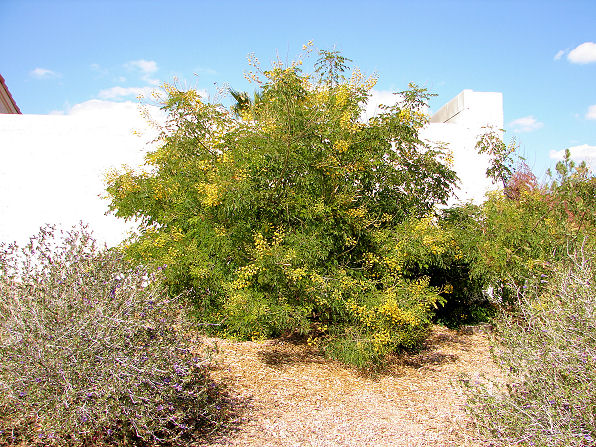 |
| Mexican Bird Of Paradise, Caesalpinia mexicana. March 13, 2006. Peoria, Arizona. |
|---|
 |
| Mexican Bird Of Paradise, Caesalpinia mexicana. March 2, 2006. Sun City, Arizona. |
|---|
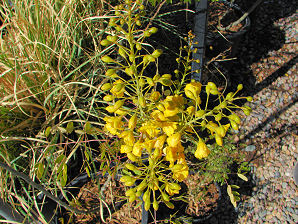 | |
| Mexican Bird Of Paradise. Caesalpinia mexicana. | Mexican Bird Of Paradise. Caesalpinia mexicana. |
|---|---|
 | 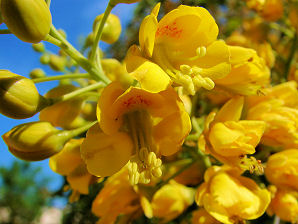 |
| Mexican Bird Of Paradise. Caesalpinia mexicana. | Mexican Bird Of Paradise. Caesalpinia mexicana. |
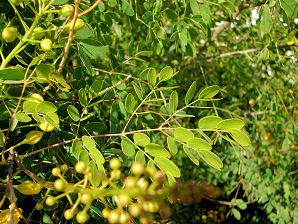 | 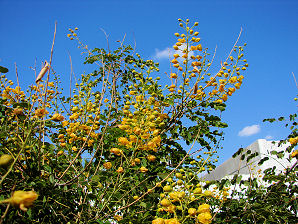 |
| Bipinnate Compound Leaf. Mexican Bird Of Paradise. Caesalpinia mexicana. | Spikes Of Yellow Clusters. Mexican Bird Of Paradise. Caesalpinia mexicana. |
 | 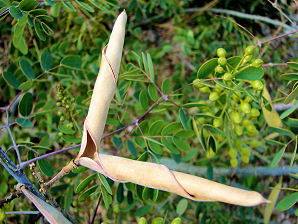 |
| Seed Pods. Mexican Bird Of Paradise. Caesalpinia mexicana. | Open Seed Pods. Mexican Bird Of Paradise. Caesalpinia mexicana. |
 /
/

Mexican Bird Of Paradise.
We wish to thank Wikipedia, the free encyclopedia for some of the information on this page. We share images and information with Wikipedia. Caesalpinia mexicana is a species of flowering plant in the pea family, Fabaceae. Its common names include Mexican Bird of Paradise, Mexican Poinciana, Mexican Holdback, Mexican Caesalpinia, & Tabach�n del Monte. Mexican Bird Of Paradiseis native to the extreme lower Rio Grande Valley of Texas, & south into central Mexico. Its range in Mexico includes the northeastern areas of Nuevo Leon, San Luis Potosi, & Tamaulipas; extending further south along the Gulf coast of Hidalgo, Queretaro, & Veracruz; as well as the Pacific coast in Nayarit, Jalisco, Colima, and a small portion of Sinaloa. Mexican Bird Of Paradise is is a large irregular shrub which can be trained to become a small deciduous tree. It may become an evergreen in warmer areas. It attracts hummingbirds. As we study the origin of this plant, it appears to have many theories. It is said to be originally a native of Argentina, now naturalized throughout the southwest USa. Considered by a few to be a native of Arizona. The USDA claims it is a native of the USA (AZ, CA, TX). They also say it is a native to Mexico in the states of: Nuevo Leon, San Luis Potosi, Tamaulipas, Hidalgo, Queretaro, & Veracruz. It is considered naturalized in Arizona. Spikes of solid yellow clusters on branch terminals; flowers up to 3 to 6 inches long; bloom early spring through summer. It is easy to confuse this Mexican Bird Of Paradise ( Caesalpinia mexicana ) with another Mexican Bird Of Paradise ( Caesalpinia gilliesii ).
Quick Notes:
Height: 5 to 10 feet tall, spread 4 to 6 feet. Some trees are reported to reach over 15 feet.
Flowers: Spikes of yellow clusters on branch terminals; with flowers up to 6 inches long.
Blooming Time: Late February - September.
Fruit: Tan fuzzy pod, dehiscent, curled, persistent on branches unless removed.
Leaves: Bipinnately compound, green, leaf. alternate, round leaflets.
Stems/Trunks: Greenish stems, noticeable lenticils, spineless; a slender trunk if any.
Found: The USDA claims it is a native of the USA (AZ, CA, TX). They also say it is a native to Mexico in the states of: Nuevo Leon, San Luis Potosi, Tamaulipas, Hidalgo, Queretaro, & Veracruz.
Elevation: Native from 0 - 5,000 feet.
Hardiness: Said to be frost hardy to 18 �F
Soil pH requirements:
Sun Exposure:
Habitat: Alkaline, well-drained/light soils. Sandy, desert washes, dry slopes, and mesas. An ideal landscape plant in Arizona.
Miscellaneous: Flowering Photos Taken March 2, 2006. Sun City, Arizona. March 13, 2006 Peoria, Arizona.
|



We Are Proud Of Our SafeSurf Rating!
Click On Any Of The Following Links By Amazon.Com
For Books, & Videos About Xerioscape Plants Of Arizona & The Southwest USA. No Obligation!
Back To Arizona Xeriscape Landscaping Main Page.
Back To Xeriscape Shrubs Page Two.
Back To Arizona Wild Flowers Home Page
Back To DeLange Home Page
© 1966 - Present, Audrey, Eve, & George DeLange
| © 1966 - Present, Audrey, Eve, & George DeLange |


